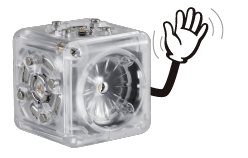We think about Cubelets in a lot of different ways, but when we were inventing them back in the mid 2000s at Carnegie Mellon, I thought of them mostly as a tangible, three-dimensional form of cellular automata. Consider it a reflection of all the computer science papers I was reading at the time. I was fascinated by distributed systems (as opposed to robots with just one brain), and Stephen Wolfram’s New Kind of Science had been published just a few years prior.
These days we usually think about Cubelets as design tools for kids. But I’m thrilled when people push the ceiling higher with Cubelets. Here, Genaro Juarez Martinez at IPN in Mexico (and a number of other colleagues, academic project is here) has built a Post machine out of Cubelets and some LEGO. A Post machine is a kind of universal computing model, like a Turing machine. Theoretically, this machine could calculate anything. And here it is, running on a bunch of parallel Cubelets, calculating some very small things.
The cool part here at the end is that Wolfram has included the Cubelets Post Machine in his Twenty Years of a New Kind of Science, a reflection about progress in cellular automata research over the last two decades. I’m pretty excited that Cubelets are part of that story!















